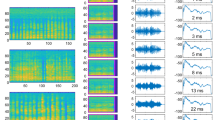Abstract
In a series of recent reports, Simmons and his colleagues propose that bats are able to accurately encode the spectral, temporal and phase information of their emitted calls and echoes. The information so encoded is then extracted by the networks of the auditory system with specialized processing. They propose that bats use this information to determine the distance to their target by crosscorrelating the entire structure of the emitted call with the structure of the echo. The idea is that slight deviations in the correlation function can be detected by the bat and the degree of mismatch provides an accurate measure of temporal disparity and hence range. The data in the reports purport to show that bats perceive the phase of ultrasonic signals and that they can resolve temporal disparities of about 10 ns, and thus can distinguish range differences as small as 2 μm.
The hypothesis also attempts to explain how a variety of acoustic cues are processed and represented in the auditory system and how they are combined to form a unitary percept of space and fine structure. The theory incorporates some time honored processes of extracting information, such as crosscorrelations. The implications of. the hypothesis, however, go far beyond a theory of neural processing and representation of information by ensembles of cells. The hypothesis requires some remarkable abilities, such as the phase coding of ultrasonic signals and a temporal acuity on the order of 10 ns. These features have never been seen in any neurophysiological study of any animal nor has its existence been implied in behavioral studies of other animals. If bats, in fact, detect and process those signals in the manner proposed by Simmons and his colleagues, it would suggest that bats are supermammals whose auditory systems have evolved new and extraordinary mechanisms not possessed by other animals.
In view of the extraordinary implications of the hypothesis, it seems prudent to critically evaluate the data upon which the hypothesis is based. The purpose of this review is to point out a number of technical problems and deficiencies in those experiments which undermine the veracity of the purported demonstration of phase perception and nanosecond time resolution by bats.
Similar content being viewed by others
References
Moiseff A, Konishi M (1981) Neuronal and behavioral sensitivity to binaural time differences in the owl. J Neurosci 1:40–48
Moss CF, Schnitzler H-U (1989) Accuracy of target ranging in echolocating bats: Acoustic information processing. J Comp Physiol A 165:383–393
Novick A (1971) Echolocation in bats: Some aspects of pulse design. Am Sci 59:198–209
Simmons JA (1969) Acoustic radiation patterns for the echolocating bats Chilonycteris rubiginosa and Eptesicus fuscus. J Acoust Soc Am 46:1054–1056
Simmons JA (1971) Echolocation in bats: Signal processing of echoes for target range. Science 171:925–928
Simmons JA (1979) The perception of phase information in bat sonar. Science 207:1335–1338
Simmons JA (1989) A view of the world through the bat's ear: The formation of acoustic images in echolocation. Cognition 33:155–199
Simmons JA, Moss CF, Ferragamo M (1990a) Convergence of temporal and spectral information into acoustic images of complex sonar targets perceived by the echolocating bat, Eptesicus fuscus. J Comp Physiol A 166:449–470
Simmons JA, Ferragamo M, Moss CF, Stevenson SB, Altes RA (1990b) Discrimination of jittered sonar echoes by the echolocating bat, Eptesicus fuscus: The shape of target images in echolocation. J Comp Physiol A 167:589–616
Stevens SS, Newman EB (1936) The localization of actual sources of sound. Am J Psychol 48:297–306
Author information
Authors and Affiliations
Rights and permissions
About this article
Cite this article
Pollak, G.D. Some comments on the proposed perception of phase and nanosecond time disparities by echolocating bats. J Comp Physiol A 172, 523–531 (1993). https://doi.org/10.1007/BF00213676
Accepted:
Issue Date:
DOI: https://doi.org/10.1007/BF00213676




